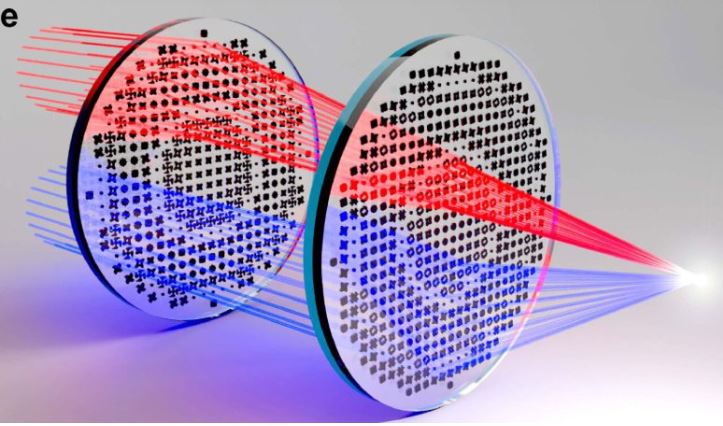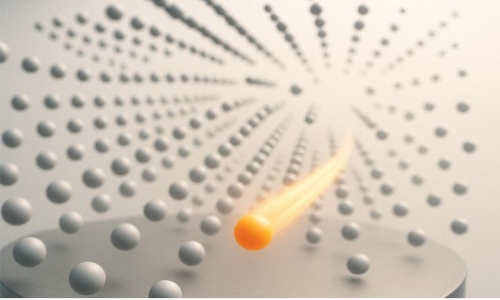


 1:3:50
1:3:50  2025-09-21
2025-09-21  741
741

Engineers created multi-layer metalenses that focus several wavelengths. The design could revolutionize portable optical devices.
Researchers have introduced a new way to create multicolored lenses that could pave the way for a generation of compact, low-cost, and high-performance optics for portable technologies like drones and smartphones.
According to Mr. Joshua Jordaan, lead author of the study from the Research School of Physics at the Australian National University and the ARC Centre of Excellence for Transformative Meta-Optical Systems (TMOS), the design employs stacked layers of metamaterials. These layers make it possible to focus multiple wavelengths from an unpolarized light source across a wide diameter, addressing one of the main drawbacks of traditional metalenses.
“Our design has a lot of nice features that make it applicable to practical devices.”
“It’s easy to manufacture because it has a low aspect ratio and each layer can be fabricated individually and then packaged together, it’s also polarization insensitive, and is potentially scalable through mature semiconductor nanofabrication platforms,” Mr Jordaan said.
The project was led by researchers from the Friedrich Schiller University Jena in Germany as part of the International Research Training Group Meta-ACTIVE. The paper reporting their design was recently published in Optics Express.
Overcoming single-layer limits
Metalenses are only a tiny fraction of a hair’s width, making them vastly thinner than traditional lenses. They can also be engineered with features like focal lengths that would be unattainable using standard optical designs.
Mr. Joshua Jordaan explained that the team first tried to focus several wavelengths using just one layer, but this approach quickly ran into fundamental physical limitations.
“It turns out the maximum group-delay attainable in a single-layer metasurface has physical limitations, and these in turn set upper bounds on the product of the numerical aperture, physical diameter, and operating bandwidth.”
“To work at the wavelength range we needed, a single layer would either have to have a very small diameter, which would defeat the purpose of the design, or basically have such a low numerical aperture that it’s hardly focusing the light at all,” he said.
“We realized we needed a more complex structure, which then led to a multi-layer approach.”
Multi-layer design breakthrough
Once the researchers shifted to a design with multiple metalens layers, they tackled the challenge using an inverse design algorithm that relied on shape optimization. This approach allowed for a high degree of flexibility through extensive parameterization.
They directed the algorithm to identify metasurface geometries that, at a single wavelength, would generate resonances in both the electric and magnetic dipoles, known as Huygens resonances. By leveraging these resonances, the team advanced beyond earlier efforts by other groups, producing metalens designs that were insensitive to polarization and more tolerant of variations in fabrication — an essential step toward scaling production for industrial use.
Unexpected shapes and applications
The optimization routine came up with a library of metamaterial elements in a surprising range of shapes, such as rounded squares, four-leaf clovers, and propellers.
These tiny shapes, around 300 nm tall and 1000 nm wide, spanned the full range of phase shifts, from zero to two pi, enabling the team to create a phase gradient map to achieve any arbitrary focusing pattern – although they were initially just aiming for a simple ring structure of a conventional lens.
“We could, for example, focus different wavelengths into different locations to create a color router,” Mr Jordaan said.
However, the multilayer approach is limited to a maximum of around five different wavelengths, Mr Jordaan said.
“The problem is you need structures large enough to be resonant at the longest wavelength, without getting diffraction from the shorter wavelengths,” he said.
Future uses for imaging
Within these constraints, Mr. Jordaan said the ability to make metalenses to collect a lot of light will be a boon for future portable imaging systems.
“The metalenses we have designed would be ideal for drones or earth-observation satellites, as we’ve tried to make them as small and light as possible,” he said.
Reality Of Islam |
|

A research

Researchers

If you'
 9:3:43
9:3:43
 2018-11-05
2018-11-05
10 benefits of Marriage in Islam
 7:5:22
7:5:22
 2019-04-08
2019-04-08
benefits of reciting surat yunus, hud &
 9:45:7
9:45:7
 2018-12-24
2018-12-24
advantages & disadvantages of divorce
 11:35:12
11:35:12
 2018-06-10
2018-06-10
 6:0:51
6:0:51
 2018-10-16
2018-10-16
 8:25:12
8:25:12
 2022-03-09
2022-03-09
 6:14:3
6:14:3
 2023-01-18
2023-01-18
 12:10:56
12:10:56
 2022-11-17
2022-11-17
 4:25:57
4:25:57
 2023-02-11
2023-02-11
al-hussain (peace be upon him)
 10:18:1
10:18:1
 2022-09-21
2022-09-21
 3:43:50
3:43:50
 2022-11-05
2022-11-05
 6:14:17
6:14:17
 2018-06-21
2018-06-21
 5:41:46
5:41:46
 2023-03-18
2023-03-18
| LATEST |